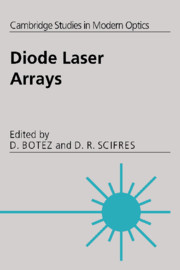Book contents
- Frontmatter
- Contents
- List of contributors
- Preface
- 1 Monolithic phase-locked semiconductor laser arrays
- 2 High-power coherent, semiconductor laser, master oscillator power amplifiers and amplifier arrays
- 3 Microoptical components applied to incoherent and coherent laser arrays
- 4 Modeling of diode laser arrays
- 5 Dynamics of coherent semiconductor laser arrays
- 6 High-average-power semiconductor laser arrays and laser array packaging with an emphasis on pumping solid state lasers
- 7 High-power diode laser arrays and their reliability
- 8 Strained layer quantum well heterostructure laser arrays
- 9 Vertical cavity surface-emitting laser arrays
- 10 Individually addressed arrays of diode lasers
- Index
10 - Individually addressed arrays of diode lasers
Published online by Cambridge University Press: 10 November 2009
- Frontmatter
- Contents
- List of contributors
- Preface
- 1 Monolithic phase-locked semiconductor laser arrays
- 2 High-power coherent, semiconductor laser, master oscillator power amplifiers and amplifier arrays
- 3 Microoptical components applied to incoherent and coherent laser arrays
- 4 Modeling of diode laser arrays
- 5 Dynamics of coherent semiconductor laser arrays
- 6 High-average-power semiconductor laser arrays and laser array packaging with an emphasis on pumping solid state lasers
- 7 High-power diode laser arrays and their reliability
- 8 Strained layer quantum well heterostructure laser arrays
- 9 Vertical cavity surface-emitting laser arrays
- 10 Individually addressed arrays of diode lasers
- Index
Summary
Introduction
One method by which the rate of information transmission can be increased is by the use of multiple, independently addressable sources to form parallel data channels. In the optical domain, this may be implemented by semiconductor diode lasers, which can be fabricated into monolithic arrays of emitters. The purpose of this chapter is to describe the development of linear arrays of index-guided diode lasers, and indicate directions in which the technology may proceed. Note that all the discussions in this chapter will be confined to semiconductor diode lasers in which the light propagates parallel to the epitaxial planes.
A few words are in order to explain the motivations that have driven the development of individually addressed diode laser arrays. Early work included the fabrication of both AlGaAs and InGaAsP devices for parallel data transmission through bundles of optical fibers, and arrays of lasers have often been considered in optical printing or optical data processing applications. The application that has been most responsible for the development of these devices, however, is optical data storage. This discussion will focus on the use of multielement arrays in optical recording systems, as a very useful example that has driven diode laser array technology towards certain performance capabilities.
- Type
- Chapter
- Information
- Diode Laser Arrays , pp. 414 - 443Publisher: Cambridge University PressPrint publication year: 1994



